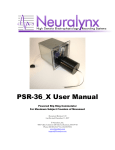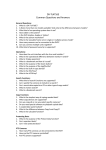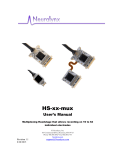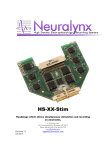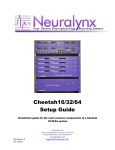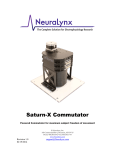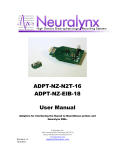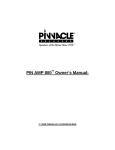Download PSR-36_x User Manual
Transcript
PSR-36-X User Manual Powered Slip Ring Commutator For Maximum Subject Freedom of Movement Neuralynx, Inc. 105 Commercial Drive, Bozeman, MT 59715 Phone 406.585.4542 • Fax 866.585.1743 www.Neuralynx.com Revision 1.1 5/16/2013 [email protected] Table of Contents 1 2 3 4 Document Overview ................................................................................................... 3 PSR-36_X Overview .................................................................................................. 3 Glossary ...................................................................................................................... 4 Hardware ..................................................................................................................... 5 4.1 Specifications ....................................................................................................... 5 4.2 Board, Connectors and Parts ................................................................................ 5 4.2.1 Motor Controller Board ................................................................................ 5 4.2.2 Configuration Header.................................................................................... 6 4.2.3 Input and Output Connectors ........................................................................ 6 4.2.4 Power Supply and 3-pin Power Connector ................................................... 7 5 Using the PSR-36_X ................................................................................................... 8 5.1 Pre-Configuration Steps (for upgrade kits only) .................................................. 8 5.2 Configuring and Testing Your PSR (for upgrade kits only) .............................. 11 5.2.1 The Speed Range of a PSR ......................................................................... 11 5.2.2 Configuration .............................................................................................. 11 5.2.3 Testing......................................................................................................... 11 5.2.4 Reconfiguration Tips .................................................................................. 12 5.3 Mounting ............................................................................................................ 13 6 Jumper Settings ......................................................................................................... 14 List of Figures and Tables Figure 4-1 Motor Controller Board..................................................................................... 5 Figure 4-2 Jumper Configuration Banks............................................................................. 6 Figure 4-3 PSR Tether Connectors ..................................................................................... 6 Figure 4-4 MDR-50 Connector ........................................................................................... 7 Figure 4-5 3-Pin Power Connector ..................................................................................... 7 Figure 5-1 Temporary Mounting of PSR ............................................................................ 8 Figure 5-2 Securing the PSR............................................................................................... 9 Figure 5-3 PSR Housing Partially Removed ...................................................................... 9 Figure 5-4 Removing the Power Connector ..................................................................... 10 Figure 5-5 Pushing MDR-50 Connector through Grommet ............................................. 10 Figure 5-6 Gently Gripping the Flex Tether ..................................................................... 12 Figure 6-1 Jumper Settings ............................................................................................... 14 Figure 6-2 Example Jumper Configuration ...................................................................... 14 Revision 1.1 5/16/2013 PSR-36_x User Manual Page 2 1 Document Overview This document describes the hardware, operation, configuration and mounting of the Powered Slip Ring Commutator (PSR-36_X). It also describes the improved motor controller board and tether used in PSR-36_X’s. Users of PSR’s purchased before December 1, 2007 like the PSR-42 and PSR-76 can upgrade to the new motor controller board by contacting Neuralynx. PSR’s purchased after December 1, 2007 are pre-configured at Neuralynx. Sections 5.1 and 5.2 on configuration and testing are only needed by those interested in upgrading PSR’s purchased before the above date. 2 PSR-36_X Overview The PSR-36_X uses a slip ring commutator to allow rotation of the signal tether while the signal cabling to the Digital Lynx Data Acquisition System remains stationary. A precision sensor monitors any twisting force on the tether so the PSR can respond immediately to animal movement and keep the signal tether untwisted. This minimizes the impact of the tether on animal behavior and eliminates stress on the tether. • New Tether New PSR’s use flex circuit “tape” tethers instead of individual wires bundled in a black sleeve. Flex circuits are extremely durable but an even greater benefit is that they have very low torsional stiffness. This improves the precision and sensitivity of the optical torque sensor to subject movement. It also eliminates the resistance exhibited by heavier, more rigid tethers. Each flex circuit tether connects to one headstage. A PSR-36_X supports 1 to 4 tethers where X indicates the number of tethers. • Improved Motor Controller Board The first version of the controller board provided quick response and fixed rate rotational adjustment to animal movement. The revised board adds smooth motor speed ramping and user configurability making the PSR even more responsive and increasing its range of speed. See section “5.2.1 The Speed Range of a PSR,” for details. The new controller board also supports an optional remote for manually controlling the direction of PSR rotation. The PSR’s quieter and smoother operation also reduces noise in the lab and vibration in the tether. Revision 1.1 5/16/2013 PSR-36_x User Manual Page 3 3 Glossary Digital Lynx Data Acquisition System – Hardware interface for low noise neural data acquisition using flexible referencing. Powered Slip Ring Commutator (PSR) – Rotating motor controlled cylinder that allows torque free rotation of the signal tether passed through it. Fine Wire Tether – Wires bundled together coaxially in a protective sleeve. Flex Circuit – Wires grouped closely side by side in a flexible, durable and lightweight tape. Headstage – Low noise unity gain buffer amplifiers placed near the recording site of an electrode. Slip Ring – Conductor that bridges the connection between fixed wires entering the PSR cylinder and matching wires that extend from the rotating end of the PSR cylinder. Tether – Signal cabling that leaves the bottom of the PSR and connects to a subject headstage. New PSR’s use flex circuits. Older PSR’s such as the PSR-42 and PSR-76 have fine wire tethers. Revision 1.1 5/16/2013 PSR-36_x User Manual Page 4 4 Hardware 4.1 Specifications • • • • • • • • Signals per Headstage: 41 signal lines including stimulus and references, 12 lines for power and internal sensors. Tether Connector(s): 1 to 4 flex circuit jumper boards or the appropriate tether adapter board(s) for headstages without a flex circuit output Output Connector(s): 1 to 4 MDR-50s Power: 12VDC Accessories: AC to 12VDC power adapter, 3-pin power connector, 12 jumpers Motor Speed Range: User configurable from 20-300 Pulses Per Second (PPS). This is equivalent to 4-60 Revolutions Per Minute (RPM) Torque Sensor Responsiveness: User configurable from 3 to 12 degrees. Auto or Manual Control Modes: Contact Neuralynx to request a manual control remote. 4.2 Board, Connectors and Parts 4.2.1 Motor Controller Board The motor controller board contains the interface to the signal cable torque sensor, the stepper motor drive circuitry and a Xilinx device to control the stepper motor based on sensor inputs. It also contains two connector headers the user must locate if upgrading their PSR; a 3-pin power header and a 34-pin jumper configuration header. Figure 4-1 Motor Controller Board Revision 1.1 5/16/2013 PSR-36_x User Manual Page 5 4.2.2 Configuration Header Four banks of jumper inputs allow the user to tailor the PSR performance to the characteristics of their experiment and conditions of their lab environment. Each bank of jumpers represents a different parameter the user can adjust. There are three pins each for configuring minimum speed, maximum speed and rate of acceleration. Two pins configure the sensitivity threshold. Increasing this threshold can reduce unintended commutator rotation in environments prone to vibration. The three pins labeled “man,” connect to an optional control used to rotate the PSR manually. Figure 4-2 Jumper Configuration Banks * See section “6 Jumper Settings” for a table of all jumper settings. 4.2.3 Input and Output Connectors An appropriate adapter or jumper board is required to join the PSR tether to a headstage tether. Figure 4-3 shows three examples. Figure 4-3 PSR Tether Connectors Flex to uDB-37 (left), Flex to Flex Jumper (center), Flex to Omnetics (right) Revision 1.1 5/16/2013 PSR-36_x User Manual Page 6 The acquisition signals that are passed through the PSR exit the PSR housing on 1 to 5 cables terminated with MDR-50 connectors. MDR-50 extension cables can then be used to run these signals to a Digital Lynx system. Figure 4-4 MDR-50 Connector 4.2.4 Power Supply and 3-pin Power Connector The PSR-36_X is powered by an AC to 12VDC power adapter that is included with the PSR. The PSR-36_X power port is easily found on the outside of the metal PSR housing. Upgrading a PSR requires removing the metal housing along with the 3-pin power connector that is fixed to it. A separate 3-pin power connector (Figure 4-5) is provided with PSR upgrade kits to allow powering of the motor controller board with the housing completely removed. Figure 4-5 3-Pin Power Connector Revision 1.1 5/16/2013 PSR-36_x User Manual Page 7 5 Using the PSR-36_X The PSR is fully self-contained. Once power is applied, it will always attempt to align the cables to remove any torque on them relative to the start position. Because the start position is determined at the moment power is applied, it is important to apply power only after making sure that the cables are untwisted and without any torque on them. If you purchased your PSR after December 1, 2007 it is already configured and you may proceed to section “5.3 Mounting.” 5.1 Pre-Configuration Steps (for upgrade kits only) Required tools and parts: PSR-36_X, 3-pin power connector, 12VDC power supply, up to 11 jumpers, Philips screw driver Recommended tools: one or two padded bar clamps 1. Carefully disconnect and remove your PSR from where it is mounted. 2. Find a stable place to temporarily and securely mount your PSR. Figure 5-1 shows a typical test setup. This PSR platform spans two tables at about waist level. Figure 5-1 Temporary Mounting of PSR In this example the platform is held firmly in place by two padded bar clamps. If you use bar clamps be sure not to clamp down the metal housing, it will be removed in the next step. Revision 1.1 PSR-36_x User Manual 5/16/2013 Page 8 Figure 5-2 Securing the PSR 3. Remove the four Philips screws that hold down the housing. Before removing the housing it is important to note that within the housing is a 3-pin power connector that is fixed to the housing and connected to the motor controller board. Carefully lift the housing up off the PSR platform and rest it near enough to not tug on the 3-pin power connector. Figure 5-3 PSR Housing Partially Removed Revision 1.1 5/16/2013 PSR-36_x User Manual Page 9 4. Remove the 3-pin power connector from the motor controller board and push the MDR-50 connector(s) through the grommet in the metal housing (Figure 5-4 and 5-5). Move the housing to a safe place out of the way. Figure 5-4 Removing the Power Connector Figure 5-5 Pushing MDR-50 Connector through Grommet 5. Disconnect the remaining two connectors. They are plugged into ports on the motor controller board labeled JSENSOR and JMOTOR. 6. Remove the four standoff screws that secure the controller board. Replace the current board with the motor controller board included in your upgrade kit. 7. Reinsert the standoff screws. Be careful, over-tightening the screws can damage the board. 8. Reconnect the 5x2-pin JSENSOR connector and the 8x2-pin JMOTOR connector. Revision 1.1 5/16/2013 PSR-36_x User Manual Page 10 9. Plug the supplied 3-pin power connector into the motor controller board. The connector is keyed so it can only be inserted one way. Wait until section “5.2.3 Testing,” to connect the 12VDC power supply to the 3-pin power connector. 5.2 Configuring and Testing Your PSR (for upgrade kits only) 5.2.1 The Speed Range of a PSR To begin rotation, the stepper motor that drives the PSR must overcome the friction of the commutator slip rings and the mass of the slip ring assembly and cover. The friction and mass increase as the number of channels increase. Because stepper motors are only rated for a specific level of torque, they must be started at a low enough speed to overcome the static resistance. This is the purpose of the minimum speed configuration jumpers. Because this starting speed may be too slow to track some animals, a PSR can accelerate up to a user selectable maximum speed. The physical characteristics of the PSR limit the maximum achievable speed. If the time to ramp from minimum speed to maximum speed is undesirably low, the acceleration jumpers can be used to reduce this time. Depending on the size of your PSR and its jumper configuration, time to reach maximum speed can range from less than half of one second to several seconds. 5.2.2 Configuration If you purchased your PSR after December 1, 2007 it is already configured and you may proceed to section “5.3 Mounting.” The motor controller board included in an upgrade kit comes with no jumpers installed. With no jumpers installed the PSR will operate at the lowest minimum speed, lowest maximum speed, the lowest acceleration rate and the highest sensitivity threshold. The following section “5.2.3 Testing” explains how to select the best jumper configuration for your PSR. Section “6 Jumper Settings” contains a table of all jumper settings and one example configuration. 5.2.3 Testing If at any point the motor is driven too fast it will stop turning, vibrate and make a buzzing noise. This can be stopped by manually rotating the tether back to its start position or removing power. For each configuration of jumpers you try, these steps should be followed to test it: 1. After making sure the tether is hanging free from the PSR with no torque or tension on it, apply power. Revision 1.1 5/16/2013 PSR-36_x User Manual Page 11 2. Start the motor by lightly touching or pushing the tether near where it enters the PSR. Without counter torque the motor will rotate indefinitely but that is what we want for this test. Watch the motor accelerate to a constant speed. Try this several times in each direction. Holding the tether will apply the counter-torque required to stop rotation. Figure 5-6 Gently Gripping the Flex Tether 3. Gently pinch the tether where it enters the PSR. Rotate the tether in both directions at varying distances from only enough to start the motor up to several complete revolutions. Remember that when you rotate the tether, the length of the tether inside the PSR is twisting as the PSR continually untwists it. 4. Try turning the tether back and forth only a small distance to observe the ability of the motor to start, stop and change direction quickly. 5. Remove power. 5.2.4 Reconfiguration Tips • If the motor does not stall at any point, you have a working configuration and can either: o experiment with increasing your minimum speed, maximum speed and acceleration o or reassemble your PSR and proceed to section “5.3 Mounting.” To reassemble your PSR, carefully pull the MDR-50 connector(s) back through the grommet on the PSR housing, reconnect the 3-pin power connector attached to the housing and then remount the housing to the PSR platform. • If the motor buzzes and will not turn at all, try lowering your minimum speed. • If the motor begins rotating but stalls during acceleration, try lowering the maximum speed • If the motor begins but stalls quickly after the initial movement, try reducing the rate of acceleration • Repeat section “5.2.3 Testing” after changing jumper settings. Revision 1.1 PSR-36_x User Manual 5/16/2013 Page 12 5.3 Mounting The PSR is designed to be mounted above an experiment location, usually at the ceiling of the experiment room. The PSR platform should be mounted as parallel to the floor as possible. Vibration in the mounting structure can cause the torque sensor to shift enough to cause motor rotation. If this happens with nothing attached to provide counter torque, the motor will spin continuously until counter torque is applied or power is removed. The chance of this unintended rotation occurring can be reduced by using the sensitivity threshold jumpers. Due to the difficulty of locating the Cheetah system near the ceiling, the PSR is always used with the Neuralynx tether extension, which also protects the delicate wiring from damage in a potentially hostile ceiling environment. The Neuralynx headstage buffers are able to drive up to 25 feet of tether extension cable with no increase in system noise. In most cases, the use of the PSR and extension cabling should be transparent to the performance of the system. It is suggested, however, that the power cabling for the PSR be run at least half of one meter away from the tether extension (along its entire length), in order to avoid conducting power supply noise into the electrode signals. This is not a hard requirement but is strongly recommended. The flex circuit tether exiting the bottom of the PSR is connected to the headstage tether using the appropriate adapter board. The tether and headstage assembly are usually left plugged in after mounting. The animal is disconnected and reconnected to the hanging tether and headstage each day. Revision 1.1 5/16/2013 PSR-36_x User Manual Page 13 6 Jumper Settings In the Jumper Setting columns a ‘1’ indicates the presence of a jumper. Minimum Speed (PPS) 20 25 30 40 50 60 65 70 Maximum Speed (PPS) 80 90 100 125 150 175 225 300 Jumper Setting 000 001 010 011 100 101 110 111 000 001 010 011 100 101 110 111 Acceleration 1 2 3 4 5 6 7 8 Sensitivity (degrees) 3 6 9 12 Jumper Setting 000 001 010 011 100 101 110 111 00 01 10 11 Figure 6-1 Jumper Settings Figure 6-2 shows an example configuration with minimum speed set to 100 for 50PPS, 011 for a maximum speed of 125PPS, 001 for an acceleration rate of 2 and 01 to set the sensitivity threshold to 6 degrees. Figure 6-2 Example Jumper Configuration * Individual PSR’s are not guaranteed to start at all minimum speeds or be capable of ramping up to all maximum speeds. Each PSR’s speed range will depend on its physical characteristics. Using the jumpers effectively provides many working configurations. Revision 1.1 5/16/2013 PSR-36_x User Manual Page 14














